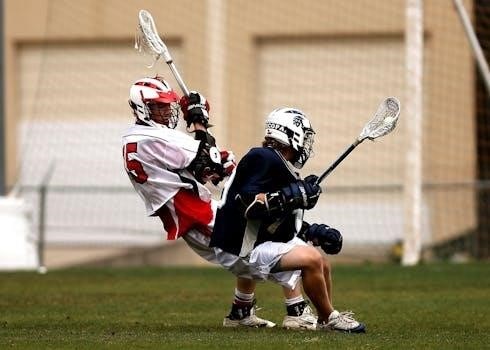Selecting the right field hockey stick size is crucial for optimal performance and player development. A well-sized stick enhances control, accuracy, and overall gameplay, ensuring comfort and confidence on the field. Use our comprehensive guide to find your ideal stick size.
Choosing the correct field hockey stick size is a foundational element for any player, significantly impacting their ability to control the ball and execute skills effectively. This guide aims to demystify the sizing process, providing a clear understanding of how to select a stick that fits an individual’s height and playing style. We will delve into various methods for determining the appropriate stick length, ensuring players can confidently choose equipment that maximizes their potential on the field. Understanding the nuances of stick sizing is the first step toward enhancing performance and preventing injury.

Importance of Correct Stick Size
Selecting the proper stick size in field hockey is critical. It directly impacts player performance, control, and comfort. An ill-fitting stick can hinder development and increase the risk of injury, making correct sizing essential.
Impact on Performance and Control
The right field hockey stick length significantly impacts a player’s performance and control. A stick that is too long can be cumbersome, hindering quick movements and close control. Conversely, a stick that is too short may compromise hitting power and reach; Proper sizing ensures optimal ball handling, passing accuracy, and shooting effectiveness. Correct stick size allows for a more natural feel and better connection with the ball, boosting confidence and overall gameplay. Ultimately, a well-fitted stick maximizes a player’s potential on the field.
Preventing Injury
Selecting the correct field hockey stick size is crucial in preventing injuries. An improperly sized stick can lead to awkward posture and strained movements, increasing the risk of back pain, wrist injuries, and shoulder problems. Using a stick that is the right length promotes a more natural and ergonomic stance, reducing the strain on the body. Proper technique, combined with a correctly sized stick, minimizes the likelihood of overuse injuries and ensures a safer and more enjoyable playing experience. Prioritize your health by choosing the right stick.
Methods for Determining Stick Size
Several methods exist to determine the correct field hockey stick size. These include height-based charts, the hip bone measurement method, and the belly button rule for juniors. Each offers a way to find the right fit.
Height-Based Charts
Height-based charts are a common method for selecting a field hockey stick. These charts correlate player height with the recommended stick length, typically measured in inches. Using these charts, players can find a suitable starting point for their stick size, which can then be adjusted based on personal preference. For example, a player who is 5’11” might start with a 38-inch stick. Remember that these charts provide a guideline and individual comfort should always be considered.
The Hip Bone Measurement Method
The hip bone measurement method is another reliable way to determine the appropriate field hockey stick size. To use this method, stand upright with shoes on and measure the distance from the ground to your hip bone. This measurement, typically in inches, corresponds to the recommended stick length. This method ensures the stick reaches a comfortable height that allows for proper posture and control during gameplay. Remember to account for personal preference when finalizing your stick selection.
Belly Button Rule for Juniors
For junior players, the belly button rule is a simple and effective way to estimate the correct field hockey stick size. Have the player stand up straight, and the stick should reach their belly button. This rule allows for some growth while ensuring the stick isn’t too long, which can hinder development and control. It is important to note that every child is different, and their height, strength, and skill level may affect the best stick size for them.

Field Hockey Stick Size Chart
Choosing the right field hockey stick size can greatly improve your performance and comfort. Consult our comprehensive size chart to find the ideal stick length based on your height and age group for optimized gameplay.
Comprehensive Size Chart Based on Height
Selecting the right field hockey stick size depends primarily on the player’s height. This comprehensive size chart correlates height with recommended stick length, providing a starting point for finding the best fit. For players under 5’2″, stick lengths typically range from 28 to 34 inches. Taller players, around 5’8″ and above, may prefer sticks of 36.5 inches or longer. Remember that personal preference and playing style can also influence the final decision, allowing for slight adjustments to the recommended size. Always consider comfort and control when making your selection.
Age Group Recommendations
While height is a primary factor, age group recommendations offer a general guideline for selecting field hockey stick sizes. Younger players, typically aged 4-6, often use sticks around 28 inches. As players grow, the stick size increases accordingly. For example, players aged 7-9 might use a 31-inch stick, while those aged 10-12 could use a 34-inch stick. However, individual variations in height and skill level should always be considered. The “belly button rule” is also a popular guideline for juniors, ensuring the stick doesn’t hinder their development.
Stick Weight Considerations
The weight of a field hockey stick impacts a player’s ability to generate power and maintain control. Consider a stick’s weight to optimize performance, balancing quick movements with the force behind your hits.
Impact of Weight on Play
The weight of your field hockey stick significantly influences your play. Lighter sticks promote quicker wrist movements, facilitating faster reactions and stick handling. They’re ideal for players prioritizing agility and finesse. Heavier sticks, conversely, offer more power behind hits, beneficial for players focusing on strength and long-range shots. Selecting the right weight depends on your playing style and position, finding a balance that optimizes both control and power on the field. Experiment to determine what feels best and enhances your performance. Consider how weight affects your endurance during longer matches.
Weight Ranges for Adult Sticks
Adult field hockey sticks typically range in weight from 19 to 21 ounces (approximately 538 to 595 grams). However, regulations stipulate that the maximum allowable weight for a field hockey stick is 26 ounces (737 grams). Lighter sticks within this range are favored for their maneuverability and speed, while heavier sticks provide enhanced power for hitting. The ideal weight is a matter of personal preference and playing style, so it’s essential to test different weights to find the best fit for individual needs and performance goals.

Rules and Regulations
The International Hockey Federation (FIH) sets the standards for field hockey sticks, including size and weight. These regulations ensure fair play and safety for all players. It is important to be aware of these rules.
FIH Regulations on Stick Size and Weight
The International Hockey Federation (FIH) establishes specific rules regarding the size and weight of field hockey sticks to maintain fairness and safety; The maximum allowable weight for a field hockey stick is 26 ounces (737 grams). While there isn’t a strict length regulation for senior sticks, players typically use sticks between 35 and 37.5 inches (89-95cm). These regulations are regularly updated, so it’s important to stay informed.

Materials and Composition
Field hockey sticks are commonly crafted from materials like carbon, aramid (Kevlar), and fiberglass. These materials influence the stick’s weight, power, and feel, affecting a player’s control and performance on the field.
Common Materials⁚ Carbon, Aramid, Fiberglass
Field hockey sticks utilize various materials, each offering distinct performance characteristics. Carbon provides stiffness and power, enhancing hitting capabilities. Aramid, known as Kevlar, adds vibration dampening and durability, improving the feel upon impact. Fiberglass offers flexibility and affordability, making it a popular choice for beginners. The combination of these materials allows manufacturers to fine-tune the stick’s properties, catering to different playing styles and skill levels. The ideal material composition depends on a player’s preference and playing style.
Trying Before Buying
Trying field hockey sticks in-store is highly recommended. This allows players to assess feel, weight, and length, ensuring the stick suits their playing style and physical attributes before making a purchase.
Importance of In-Store Testing
In-store testing is vital when selecting a field hockey stick because it allows players to physically interact with various models. Feeling the stick’s weight and balance helps determine comfort and control. Players can assess grip size and shaft shape, ensuring a secure and natural feel. Swinging the stick allows for evaluating its responsiveness and power potential, crucial for optimizing performance on the field. Trying before buying minimizes the risk of selecting an unsuitable stick, ultimately enhancing player satisfaction and gameplay.
Other Considerations
Beyond size, consider playing style and personal preference. Some players favor lighter sticks for quicker movements, while others prefer heavier sticks for power. In-store testing is highly recommended.
Player Preference and Playing Style
While height-based charts and measurement methods offer a solid starting point, individual player preference and playing style significantly influence the ideal field hockey stick. Some players prefer lighter sticks for quick wrist movements, essential for close ball control and rapid passes. Others might opt for heavier sticks to generate more power when hitting or driving the ball downfield.
Consider your position and typical role on the field. Defenders might prioritize a stick that offers stability and power, while midfielders may seek a balance between control and striking ability. Ultimately, the best stick is the one that feels most comfortable and natural in your hands, allowing you to play with confidence and execute skills effectively.
Online vs. In-Store Purchase Considerations
Purchasing a field hockey stick presents a choice⁚ online convenience or in-store assessment. Online shopping offers a wider selection and competitive pricing, but lacks the ability to physically test the stick. Size charts and product descriptions are helpful, but can’t replicate the feel of a stick in your hands.
In-store purchases allow you to handle different sticks, assess their weight and balance, and even take a few practice swings. Expert staff can provide personalized recommendations based on your height, playing style, and experience level. While potentially more expensive, an in-store purchase ensures a perfect fit and reduces the risk of dissatisfaction. Consider both options carefully.